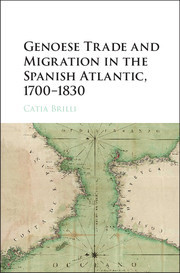Description
Genoese Trade and Migration in the Spanish Atlantic, 1700–1830
Author: Brilli Catia
In the eighteenth century Genoese merchants thrived in the changing Atlantic market. Their trade and migration are explored here.
Language: English
Subject for Genoese Trade and Migration in the Spanish Atlantic...:
Approximative price 143.80 €
In Print (Delivery period: 14 days).
Add to cart
Publication date: 04-2016
357 p. · 16x23.5 cm · Hardback
357 p. · 16x23.5 cm · Hardback
Description
/li>Contents
/li>Biography
/li>
The Republic of Genoa was once a major commercial power. Following the Republic's decline in the seventeenth century, Genoese merchants adapted and thrived in the changing Atlantic market. Scholars have examined how other foreign merchant groups operated within the Spanish empire, but until now no one has examined how the Genoese adapted to the challenges of increasing competition in Atlantic trade. Here, Catia Brilli explores how Genoese intermediaries maintained a strong presence in Spanish colonial trade by establishing themselves at the port of Cadiz with its monopoly over American trade, and through gradually consolidating strong commercial ties with the Río de la Plata. Situated at the intersection of European, Atlantic, and Latin American history and making extensive use of Spanish, Italian, and Argentinian sources, Genoese Trade and Migration in the Spanish Atlantic, 1700?1830 provides a unique perspective on eighteenth- and early nineteenth-century transatlantic trade.
Introduction; Part I. In the Shadow of Empire: 1. Genoese migration to Cadiz: a persisting alliance; 2. Carving out a place in Spanish colonial trade; 3. Migration and investments towards colonial Buenos Aires; Part II. Transcending Empire: 4. Collapse and reorientation of Genoese Atlantic trade; 5. Settling in independent Buenos Aires; Conclusion.
Catia Brilli is a research fellow in Economic History at the University of Seville and collaborates with the University 'L. Bocconi' in Milan.
© 2024 LAVOISIER S.A.S.




